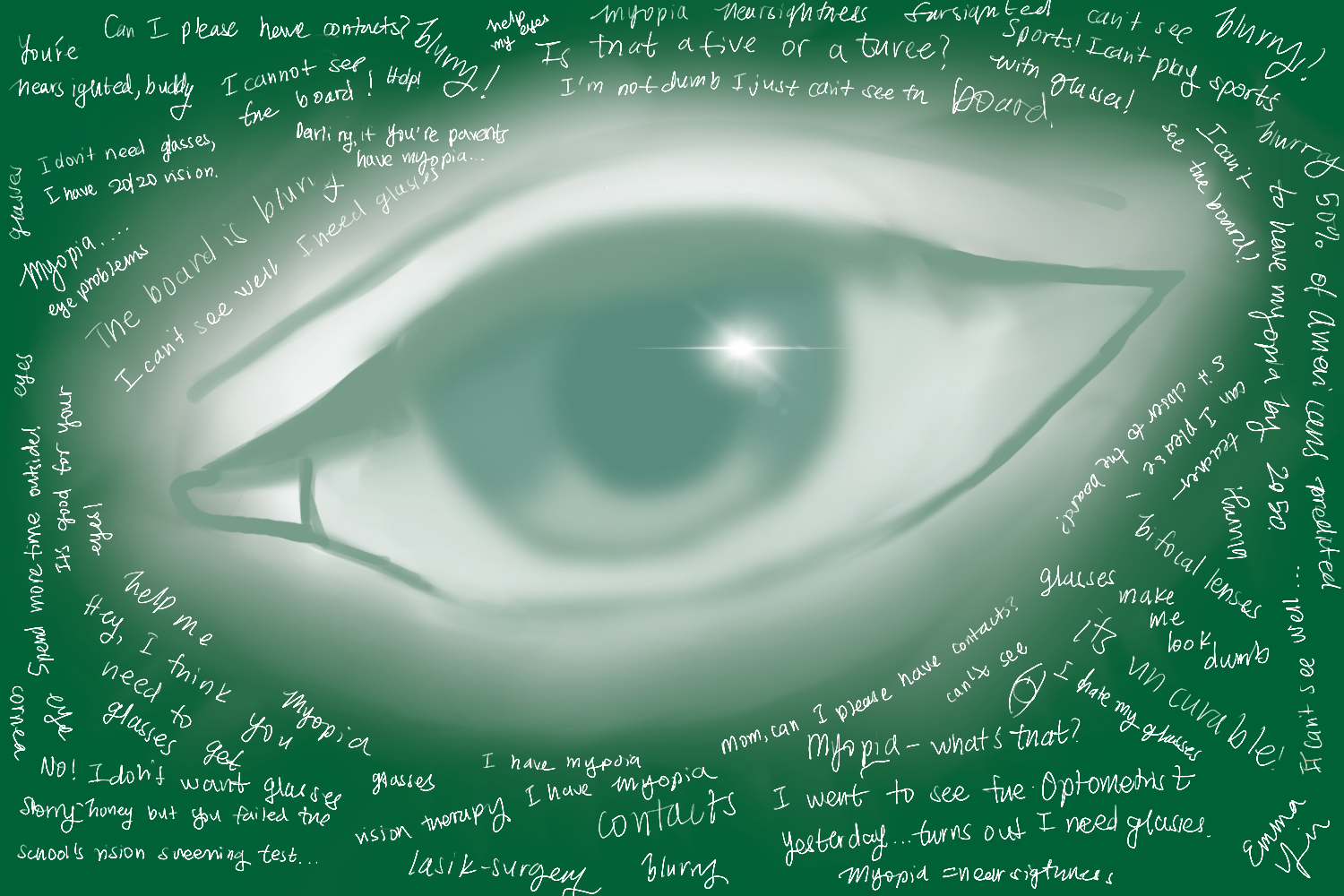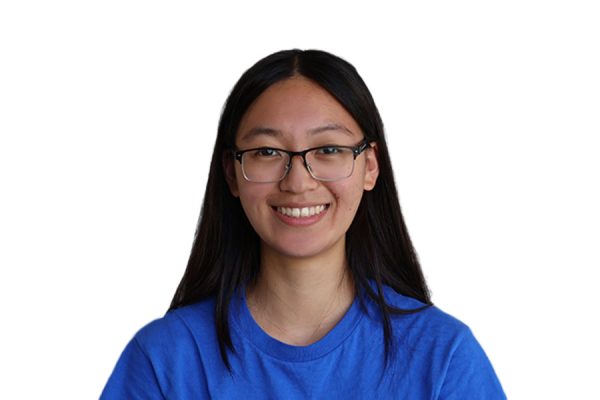Juliet squints at the fuzzy whiteboard, trying to copy down the math problem that her teacher has written. She misreads the five for a three and when the teacher calls on her, she gets it wrong. The times after that, Juliet repeatedly asks the teacher what things on the board say. Juliet is among the 30% of adolescents who have myopia, better known as nearsightedness. Myopia is when one’s eyeball is abnormally stretched or the cornea (the transparent lens of the eye covering the iris and pupil) is too curved. This causes the light coming into the eye to stop in front of the retina rather than on it. When light does not focus correctly on the retina, things in the distance may appear blurred.
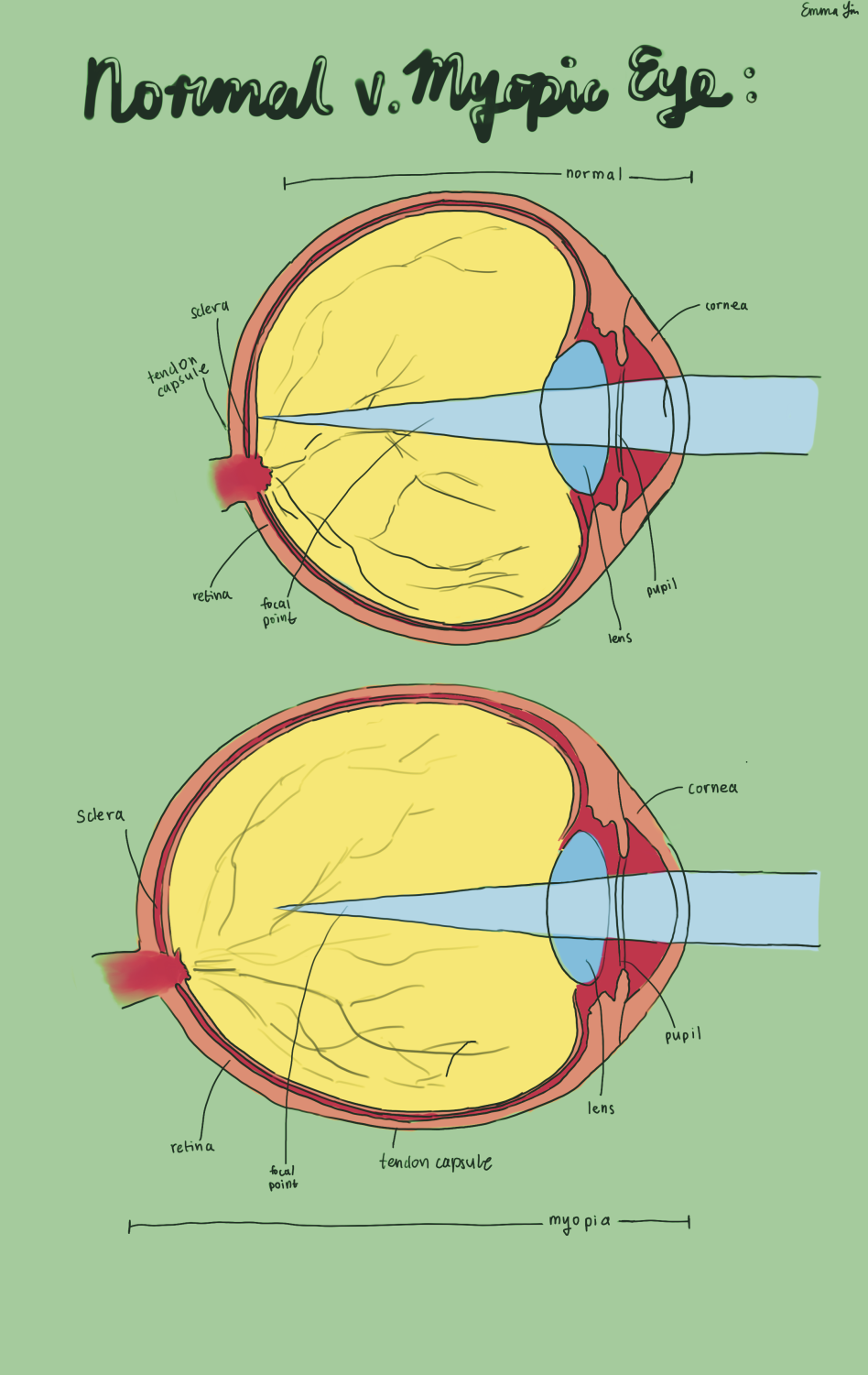
Fifth grader Juliet Lee* started wearing glasses at the request of her fourth-grade teacher, who asked her mother to take Juliet to the optometrist as Juliet was squinting a lot and had trouble seeing the board. This was during quarantine when schools were hybrid.
“Before I got my glasses, I couldn’t see that well but I was pretty happy because yay! I didn’t kill my eyesight! But after I got my glasses, I kinda yelled at myself, ‘Why is your eyesight so bad, why are you looking at screens 24/7’ but now I think that it’s okay to wear glasses, as they are good for me and I can see clearly now,” Juliet said.
Myopia is a rising problem in America, and in 2016 it was predicted by the American Academy of Ophthalmology that 50% of Americans will be nearsighted by 2050.
Dr. Carole Hong, O.D. at the Optometric Center for Family Vision Care and Vision Therapy believes that people are paying attention to myopia more because it is rising in the United States, as much as 41% of people in America have myopia now, whereas 20 years ago the percentage was less than 20%.
“The prevalence of nearsightedness may be increasing, due to a combination of less time spent outdoors, increased reading and screen time, and hereditary factors. Before the printing press, before we had books to read, and before computers and digital devices, most kids would go to school, but then they would spend hours outdoors, either playing, helping on their farm, or hunting and gathering food. These activities required very different visual skills than our students need today, so the development and progression of nearsightedness have to do with both how we use our eyes now and genetic factors,” Hong said.
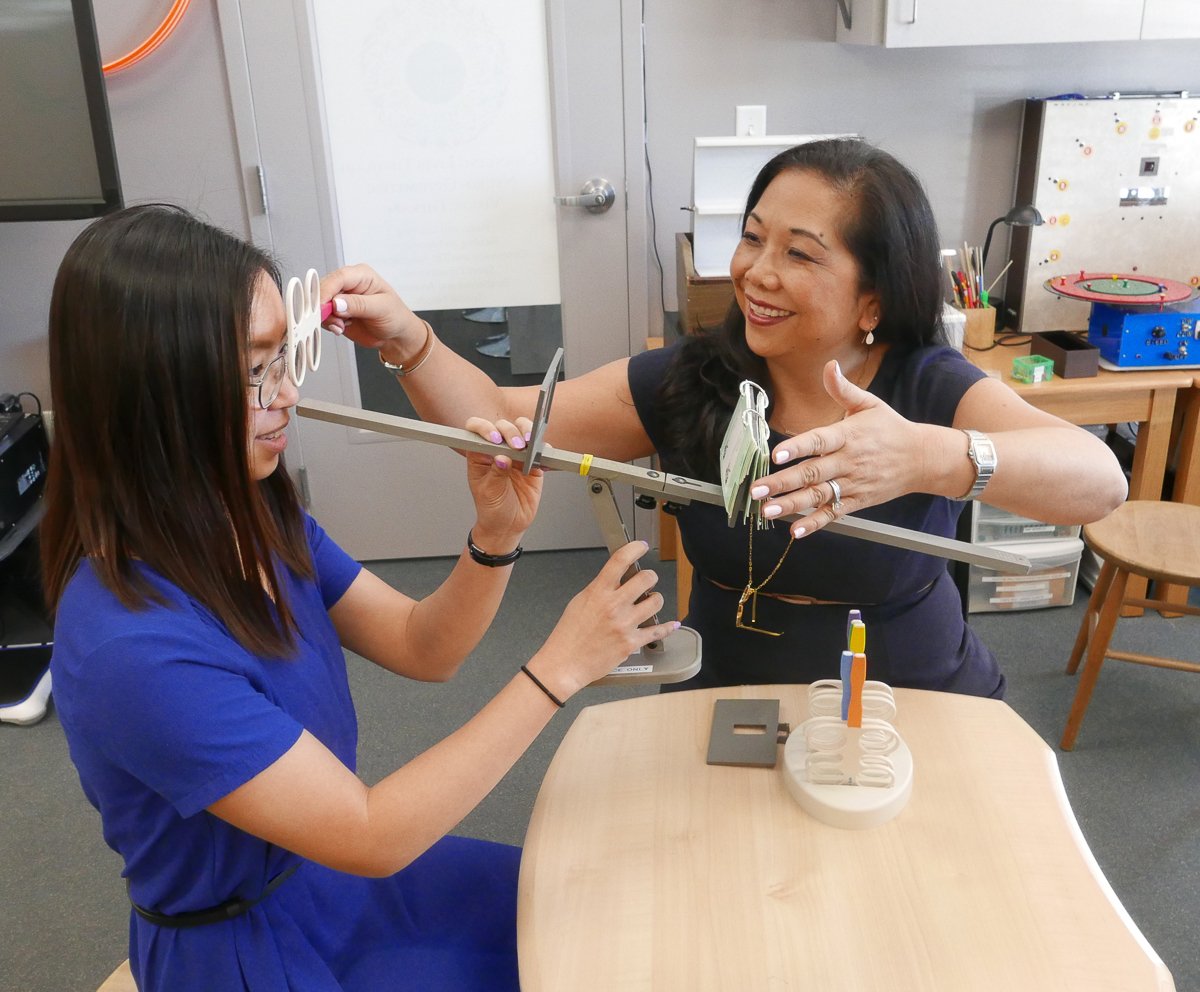
Children are three times more likely to get myopia if one parent has it and six times more likely if both parents have it. Having myopia makes it challenging for children to see the whiteboard and presentations, making visual teaching strategies that teachers use ineffective. Not only does this impact how a child learns but it makes learning frustrating and more strenuous.
“If one is nearsighted, without correction, they won’t be able to see objects in the distance, such as the board. Nearsightedness can also make it difficult to see the facial expressions of your teachers or your classmates. For instance, if you are giving an in-person presentation, you may lose some of the nuances, such as seeing if the audience understands what you are saying by looking at their facial expressions. If they look like they don’t understand then [the teacher] might elaborate on a topic,” Hong said.
Common signs that a child has myopia are squinting, bringing pages very close to the face when reading, frequent headaches and or eye rubbing, and using one eye to read.
Not only is myopia detrimental in school, but it can also affect students’ ability to play sports.
Carlmont junior Allison Hoang got glasses in seventh grade after her math teacher noticed her squinting at the board.
“Getting glasses affected everything else in my life including sports and school,” Hoang said. After being prescribed glasses, she switched to contact lenses, then hard corrective lenses.
“Now that I have corrective contacts, I can see everything clearly. Before I had them though, it was hard to read things on the board, so I was working so much slower than everyone else. While playing volleyball, it was much harder to track exactly where the ball was, especially when it was on the other side of the court, ” Hoang said.
Hoang wears hard corrective contact lenses as they allow her to go through the day without worrying about contact lenses drying or slipping out. Hard corrective lenses are worn at night and removed in the morning and are designed to reshape the cornea so that the wearer can enjoy clear vision during the day without using glasses or daytime contact lenses.
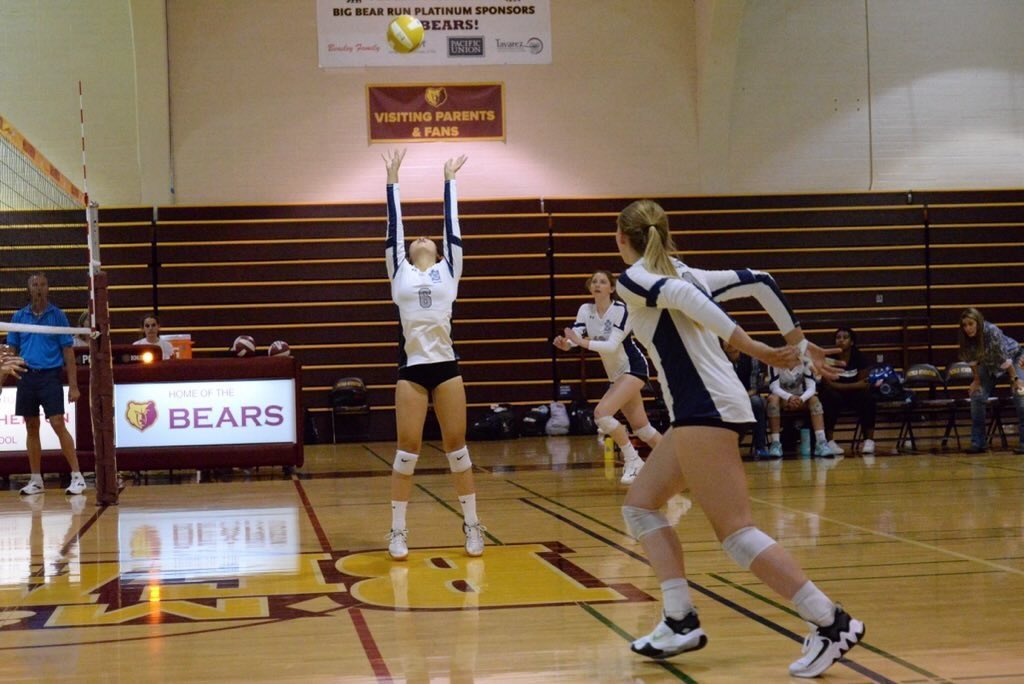
However, there are still ways to play sports without the use of hard corrective lenses.
Senior Maxwell Chou, who swims and skis, doesn’t use hard corrective lenses, instead, he has special goggles so that he can wear his glasses underneath.
“My myopia added a bit of a learning curve to swimming, making it harder to judge distance from the wall to perform flips and stops, ” Chou said.
Other students choose not to use anything to help correct their vision.
Sophomore Ilan Vinogradsky has astigmatism like his mother and older siblings. Astigmatism is very similar to myopia, in which the cornea (the transparent lens over the eye) has a mismatched cure, while myopia is when the whole cornea is steeply curved.
“Once a year I need to get my eyes dilated and I get a new prescription. I do wrestling and you can’t wear glasses during practices and whatnot so I just don’t. Everything is blurry but I manage; I can see large shapes and even in partial detail when things are close to me but when the coaches are showing things to the whole team and I am at a distance, the display becomes a little muddled,” Vinogradsky said.
In addition to causing difficulty, myopia and other eye refractive problems can lead to more health problems later on.
“Controlling the amount of myopia is so important because we now know every diopter increases in nearsightedness, and one becomes increasingly at risk for eye conditions that can affect your eyesight when you become older. So when you get your birthdays up into the 40s, 50s, and 60s, and are nearsighted, you are more at risk for macular degeneration, glaucoma, or retinal problems like retinal detachments, and all those conditions can be sight-threatening,” Hong said.
Furthermore, because myopia affects vision and hence mobility, it can also make everyday actions dangerous.
For example, recently, Dr. Hong was at a clinic where they volunteered to give free eye exams to those in need, and a person who had lost their glasses came in.
“They could only see clearly at about five inches in front of their face, and in this case, not having glasses became a hazard to their safety as it was even difficult to cross the street, let alone see to drive,” Hong said.
According to Dr. Hong, the most popular treatment or solution to compensate for myopia is getting glasses or contacts; however, there are also treatment options to slow the progression of nearsightedness as well. These include glasses in a bifocal or progressive lens form, corneal refractive lenses, soft multifocal contact lenses, MiSight contact lenses, and Atropine eye drops. In addition, vision therapy, and eye exercise tends to be encouraged for certain patients with increasing nearsightedness, especially when there are underlying focus or convergence problems.
However, not many people are as optimistic about these treatment plans.
Chou started wearing glasses after failing his annual checkup in elementary school and has worn them ever since.
“My eyesight has gotten worse and worse until I am where I am now, with glasses a quarter of an inch thick,” Chou said, “I don’t think it will improve, but there are possibilities. Lasik eye surgery is an option and the technology has improved a lot since I’ve last heard, but it can only be done once your eyesight stops deteriorating, and I’m not sure when mine will, if at all. [Myopia] is projected to stop [progressing] before my 20’s at most, but you never know.”
However, Dr. Hong believes that vision therapy helps one relax their vision so that their myopia stops increasing so drastically; in addition to preventing further myopic progression, vision therapy also helps improve the ability of the eye to focus.
“Vision therapy can work on building visual stamina so that one can sustain focus for longer periods of time. If one’s focusing system is weak, the eye elongates to compensate. Vision therapy can also improve one’s focus flexibility, changing focus from far to near and vice versa, such as when copying from the whiteboard to the page on a desk. However, when a patient’s focus gets “stuck” at a close distance, such as when looking at a cell phone, they have a problem when they look at an object in the distance, as it is blurry. This condition of inflexibility can lead to a condition called “pseudo myopia.” Patients often think that they keep needing stronger and stronger prescription lenses and sometimes don’t get treatment for the underlying focus or convergence problems,” Hong said.
Other than vision therapy, there are many things one can do to prevent and or stop myopia from increasing.
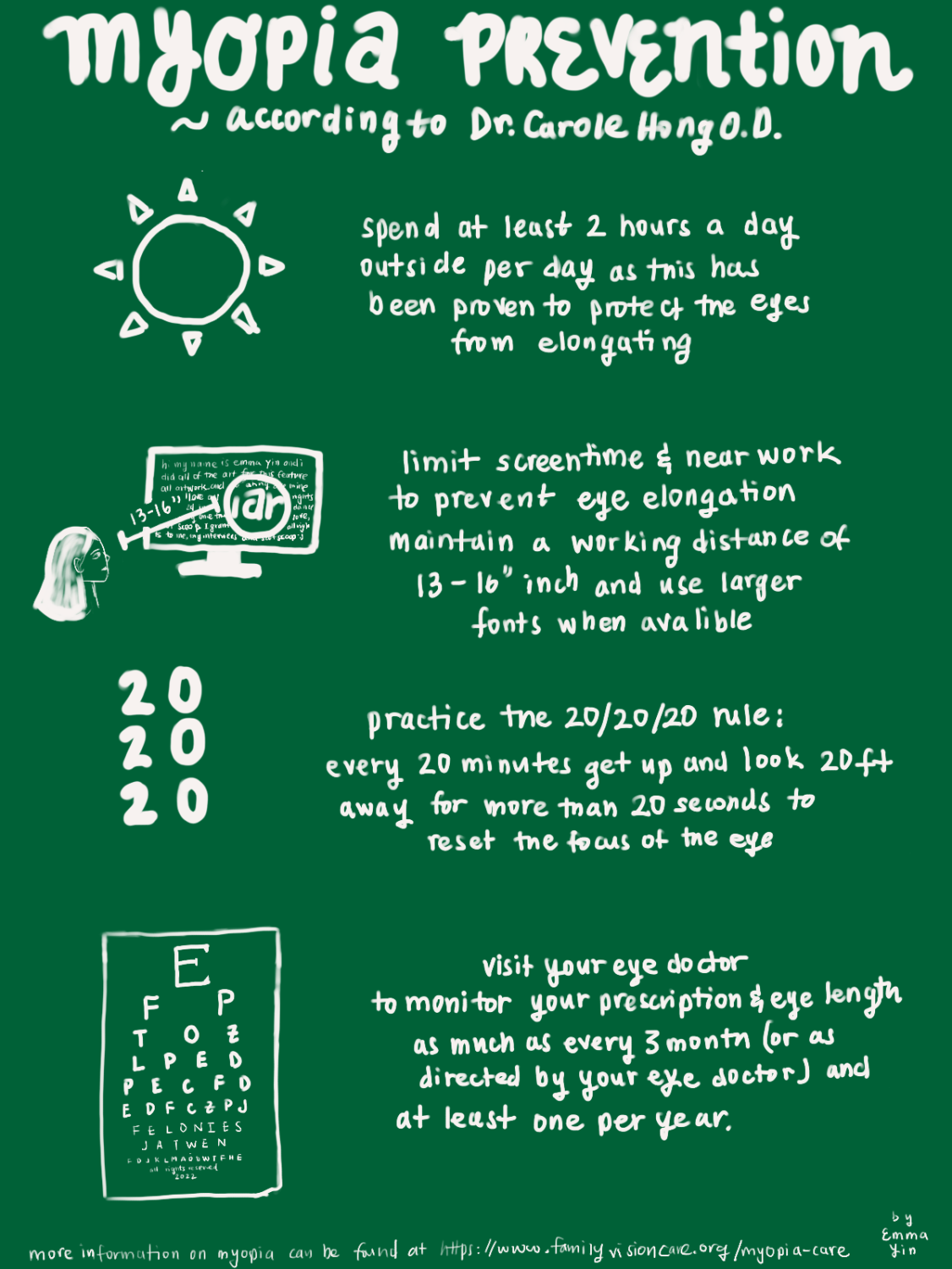
Juliet’s mother, Carol Lee* tries to take Juliet outside as much as possible and do eye acupressure massages to improve blood flow in order to protect Juliet’s eyesight.
In addition, she also tries to ensure that the time Juliet’s eyes are spent focusing on reading or close-up eye work is alleviated and easier.
“We also try to get her offline more and before she got glasses we did try to get large printed books from the library but they are hard to find so we gave up. We aren’t sure whether or not physical books or e-books are better. I prefer physical books but sometimes the font size is very small and Juliet prefers e-books because she says you can enlarge the fonts,” Lee said.
According to Dr. Hong, one can prevent myopia progression by spending time outside (at least 14 hours/week or 2 hours/day), limiting screen time and near work, maintaining a working distance of 13-16 inches away from reading and arms distance from your computer (20-28 inches), and using larger over smaller screens and fonts. In addition, it’s important for those with myopia to visit their eye doctor to monitor their prescription and axial length at least once a year.
All in all, myopia is harmful to schoolchildren and even though it is not curable, there are definitely ways to prevent and improve it.
“It is an exciting time in vision care as there is continuing research on myopia prevention, with much of that going on at UC Berkeley’s School of Optometry. There are proven methods to help students to reduce the progression of their myopia and stretching of their eyes. Parents and students can be assured that a life of poor vision and thick glasses that may have limited academic or athletic pursuits in the past will no longer be a problem. Students can maintain great vision and, most importantly, healthy eyes well into their futures, ” Hong said.
*These names were left out by the author to ensure medical privacy for the source, in accordance with Carlmont Media’s anonymous sourcing policy.


